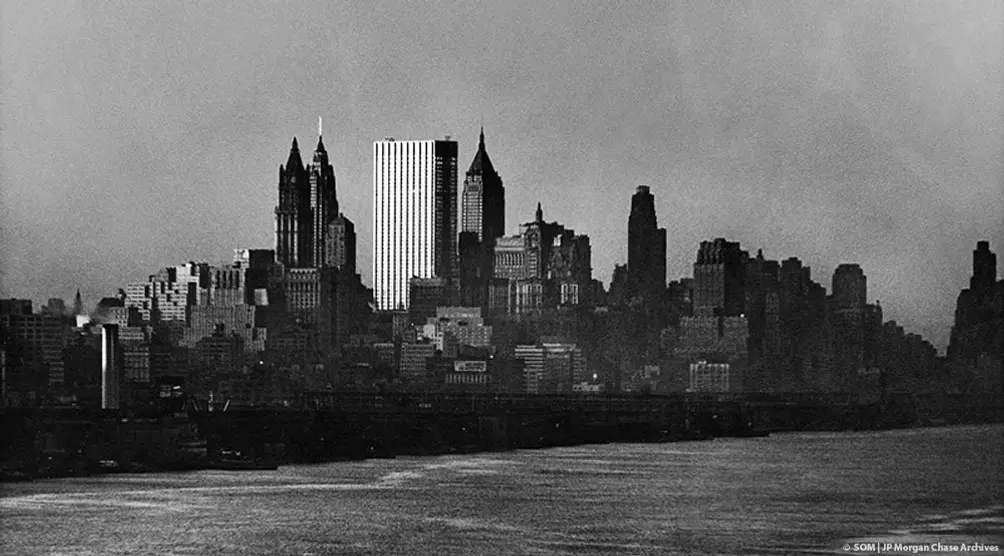 One Chase Manhattan Plaza, 1961
One Chase Manhattan Plaza, 1961
This large, shiny, boxy skyscraper at 28 Liberty Street was erected in 1960 and helped stop a corporate exodus from Lower Manhattan and led eventually a downtown renaissance that brought forth the creation of Battery Park City and the World Trade Center.
In the process, the building, known as One Chase Manhattan Plaza, created one of the world's greatest plazas as well as one of the world's greatest sunken plazas.
However, it also ruined the Lower Manhattan skyline that had been, up until its erection, the most romantic and famous in the world because of its spindly tall towers that made for an almost symmetrical silhouette. This tower has no setbacks and its 60 stories of 30,000-square-foot floors are topped by a flat roof without any skyline ornament.
However, it also ruined the Lower Manhattan skyline that had been, up until its erection, the most romantic and famous in the world because of its spindly tall towers that made for an almost symmetrical silhouette. This tower has no setbacks and its 60 stories of 30,000-square-foot floors are topped by a flat roof without any skyline ornament.
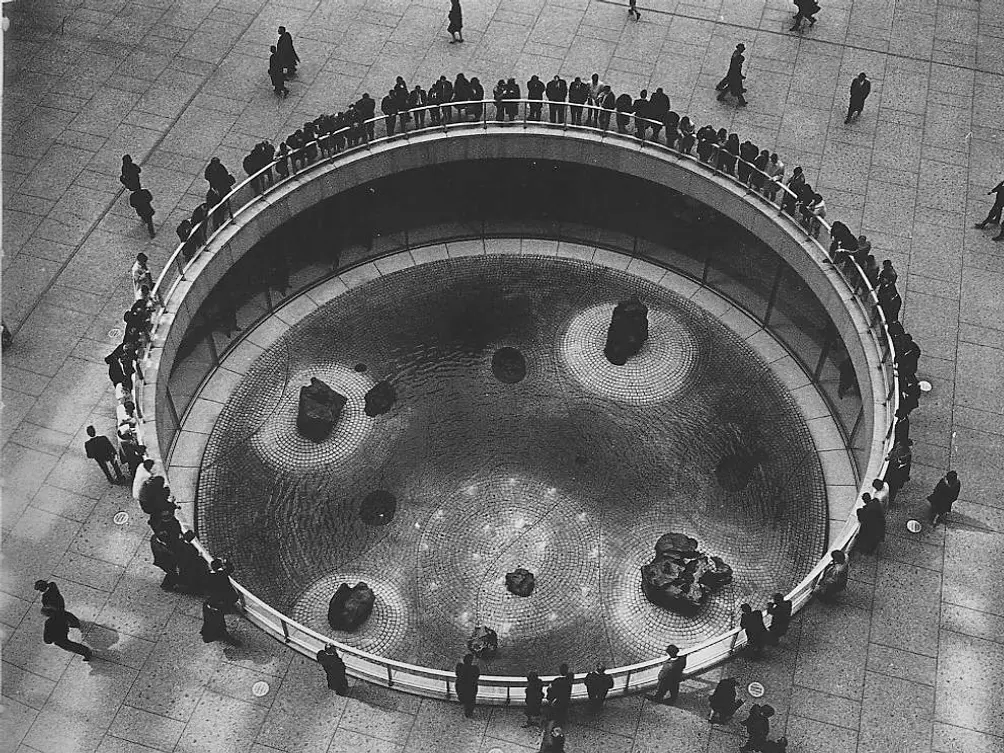 The sunken plaza, 1964
The sunken plaza, 1964
“The significance of the Chase bank’s decision went beyond the building’s contribution as architecture. The announcement of the project, more than any other singled factor, triggered the economic revitalization of lower Manhattan"
In their great book, “New York 1960, Architecture and Urbanism between the Second World War and the Bicentennial,” Robert A. M. Stern, Thomas Mellins and David Fishman noted that “in November, 1955, the Chase Manhattan Bank electrified the city’s development community with the announcement that it intended to consolidate 8,700 employees working in nine different locations in a skyscraper headquarters building in the financial district, to be designed by Skidmore, Owings & Merrill.”
“The significance of the Chase bank’s decision went beyond the building’s contribution as architecture. The announcement of the project, more than any other singled factor, triggered the economic revitalization of lower Manhattan, which had been so threatened by decline that the board of directors of the New York Stock Exchange had become alarmed for the entire financial community’s physical stability,” the authors continued.
There can be little doubt that David Rockefeller's decision to keep Chase downtown and to erect a major and imposing "modern" skyscraper was very critical to the well-being of Lower Manhattan, especially at a time when the corporate exodus to the suburbs was a major concern for the city and as many CEOs decided that they could do without the "secondary" commute from the suburbs to downtown. One need only watch such movies as "Sabrina" or "Executive Suite" to understand the culture of Lower Manhattan's views from the proverbial 40th floor.
Stunning color photographs of the harbor from the huge picture windows of the Wall Street Club on the 60th floor of the building, however, did a lot to elevate the declining status of downtown and indeed the views were stupendous and the club was probably the city's most impressive business luncheon venue.
“The significance of the Chase bank’s decision went beyond the building’s contribution as architecture. The announcement of the project, more than any other singled factor, triggered the economic revitalization of lower Manhattan, which had been so threatened by decline that the board of directors of the New York Stock Exchange had become alarmed for the entire financial community’s physical stability,” the authors continued.
There can be little doubt that David Rockefeller's decision to keep Chase downtown and to erect a major and imposing "modern" skyscraper was very critical to the well-being of Lower Manhattan, especially at a time when the corporate exodus to the suburbs was a major concern for the city and as many CEOs decided that they could do without the "secondary" commute from the suburbs to downtown. One need only watch such movies as "Sabrina" or "Executive Suite" to understand the culture of Lower Manhattan's views from the proverbial 40th floor.
Stunning color photographs of the harbor from the huge picture windows of the Wall Street Club on the 60th floor of the building, however, did a lot to elevate the declining status of downtown and indeed the views were stupendous and the club was probably the city's most impressive business luncheon venue.
But the massive bulk of the building made it a skyline bully, hogging all the attention and intimidating the thinner "boys on the beach.” Had SOM sculpted its roofline somewhat it could have mitigated a lot of the building's negative impact visually on the skyline because it was centrally located unlike the World Trade Center that was yet to come.
As a result of its construction and the leadership of David Rockefeller and his brother, Governor Nelson Rockefeller, the downtown renaissance would soon be vigorously reinforced by the construction of the World Trade Center and Battery Park City on the landfill created with the dirt of the center's excavation. A few years after it was built, the Rouse Corporation created the South Street Seaport on the East River just south of the Brooklyn Bridge with the hope that its large retail presence and historical associations would also significantly bolster downtown's status and it led to the redevelopment of Water Street.
The revelation in October 2014 that Chase was considering relocating from Lower Manhattan to a site new the Hudson Yards project in Far West Midtown, therefore, came as a great shock. The bank had sold its headquarters building the previous year to Fosun International of China for $725 million but there was no inkling it was planning to abandon Lower Manhattan and the announced indicated it would keep some space in the 2.2-million-square-foot building. It had moved its headquarters to 270 Park Avenue in 1996 but still occupied more than half the building.
Almost more shocking was the report that it was considering moving into two buildings rather than just one new “supertower,” further proof that corporations are not particularly loyal tenants and that Chase was following the lead of IBM and AT&T in abandoning their Midtown namesake skyscrapers as had AT&T’s replacement, Sony.
Moreover, these corporate behemoths were not only abandoning real estate but also their not insignificant corporate culture: IBM gave on its wonderful art gallery on Madison Avenue that held many important exhibitions; AT&T took its fabulous skyline sculpture, “The Spirit of Communications” by Evelyn Longmans, from its famous “Chippendale” tower to its new headquarters in New Jersey only to offer it back several years later to the city, which turned it down, incredulously.
As a result of its construction and the leadership of David Rockefeller and his brother, Governor Nelson Rockefeller, the downtown renaissance would soon be vigorously reinforced by the construction of the World Trade Center and Battery Park City on the landfill created with the dirt of the center's excavation. A few years after it was built, the Rouse Corporation created the South Street Seaport on the East River just south of the Brooklyn Bridge with the hope that its large retail presence and historical associations would also significantly bolster downtown's status and it led to the redevelopment of Water Street.
The revelation in October 2014 that Chase was considering relocating from Lower Manhattan to a site new the Hudson Yards project in Far West Midtown, therefore, came as a great shock. The bank had sold its headquarters building the previous year to Fosun International of China for $725 million but there was no inkling it was planning to abandon Lower Manhattan and the announced indicated it would keep some space in the 2.2-million-square-foot building. It had moved its headquarters to 270 Park Avenue in 1996 but still occupied more than half the building.
Almost more shocking was the report that it was considering moving into two buildings rather than just one new “supertower,” further proof that corporations are not particularly loyal tenants and that Chase was following the lead of IBM and AT&T in abandoning their Midtown namesake skyscrapers as had AT&T’s replacement, Sony.
Moreover, these corporate behemoths were not only abandoning real estate but also their not insignificant corporate culture: IBM gave on its wonderful art gallery on Madison Avenue that held many important exhibitions; AT&T took its fabulous skyline sculpture, “The Spirit of Communications” by Evelyn Longmans, from its famous “Chippendale” tower to its new headquarters in New Jersey only to offer it back several years later to the city, which turned it down, incredulously.
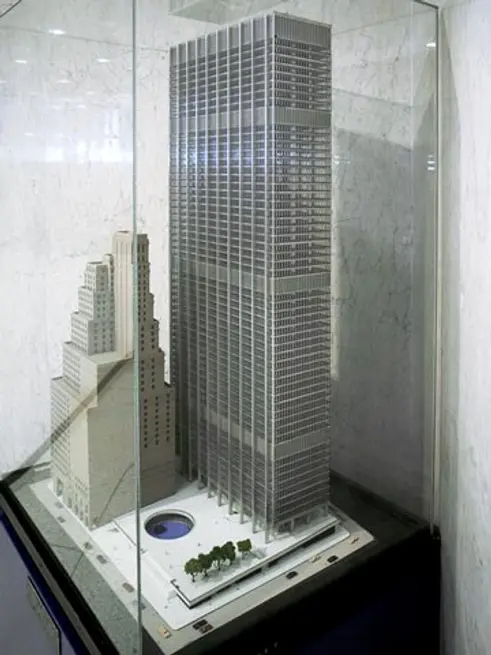 A model of the building. Photo by Brian Rose
A model of the building. Photo by Brian Rose
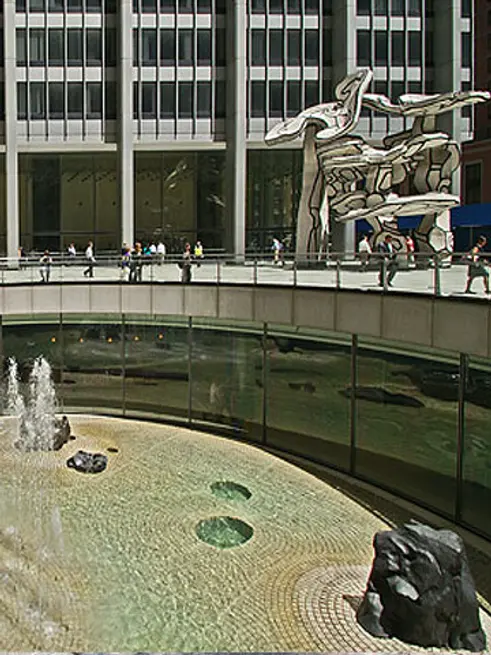 The Dubuffet sculpture
The Dubuffet sculpture
Chase had embellished its very large plaza in Lower Manhattan with two superlative and major artworks: Group of Four Trees, a 42-foot-tall white sculpture with black outlines, and Isamu Noguchi’s very fine, 60-foot-wide, circular sunken rock garden and fountain. There is no indication that they will join the bank in its planned moved to the Far West Side.
“As much as any other large-scale office building of the period, even more than Seagram’s and perhaps CBS, Chase was a work of total design. Its extraordinary design program was handled by Davis Allen of SOM, assisted by interior designer Ward Bennett….Although Bennett’s furniture and accessories (including twenty different types of ashtrays, manufactured by top craftsmen like Hermès and Gucci) were remarkable, it was the lavish use of art in public areas and executive offices that established an important trend in corporate culture,” Mr. Stern and his co-authors maintained. The authors also observed that the SOM design team early on developed “alternate” plans for two buildings on the site: a 52-story tower and a 15-story adjacent tower. The two-tower scheme was dropped in a few months.
SOM, the authors continued, “elegantly sheathed” the large slab tower in anodized aluminum, adding that “stainless steel was rejected for cost reasons, while granite was rejected because Frederick Ecker, the senior building committee member, considered that time-honored material too material.”
“The decision to use aluminum was a bold stroke: the building’s silvery metallic sheen, enhanced by its glassiness, created an instantly identifiable and virtually unforgettable contrast with the traditional masonry mass of the lower Manhattan skyline,” the authors pointed out.
“As much as any other large-scale office building of the period, even more than Seagram’s and perhaps CBS, Chase was a work of total design. Its extraordinary design program was handled by Davis Allen of SOM, assisted by interior designer Ward Bennett….Although Bennett’s furniture and accessories (including twenty different types of ashtrays, manufactured by top craftsmen like Hermès and Gucci) were remarkable, it was the lavish use of art in public areas and executive offices that established an important trend in corporate culture,” Mr. Stern and his co-authors maintained. The authors also observed that the SOM design team early on developed “alternate” plans for two buildings on the site: a 52-story tower and a 15-story adjacent tower. The two-tower scheme was dropped in a few months.
SOM, the authors continued, “elegantly sheathed” the large slab tower in anodized aluminum, adding that “stainless steel was rejected for cost reasons, while granite was rejected because Frederick Ecker, the senior building committee member, considered that time-honored material too material.”
“The decision to use aluminum was a bold stroke: the building’s silvery metallic sheen, enhanced by its glassiness, created an instantly identifiable and virtually unforgettable contrast with the traditional masonry mass of the lower Manhattan skyline,” the authors pointed out.
In midtown, of course, Lever House had introduced green glass as an alternative to masonry on Park Avenue followed a few years later by the bronze-colored Seagram Building.
Chase’s modern momentum did not fade away as in 1961 plans were announced for another slab tower nearby at 140 Broadway by Erwin Wolfson that would have masonry sunshades but when Harry B. Helmsley took over the project he had it enlarged to 52-stories and redesigned by Gordon Bunshaft with a very sleek black curtain wall that contrasted brilliantly not only with the silvery Chase tower but also with Noguchi’s bright red cube sculpture in its plaza.
Architectural Forum magazine, devoted 30-page article to the tower and wrote that “Chase is a milestone, perhaps even an end point in the best development of the American skyscraper, which for decades has been the summit meeting place of business, engineering and art. In many big office buildings, the result speaks of a clear victory for one of these, or at best an uneasy truce. Chase reconciles and balances the three, and each in its most advanced form; it works, and looks, like a big handsomely designed business machine, its complex anatomy of systems multiples the efforts of its users… art has not been spooned on for appearances, but carefully integrated it into every detail down to the paperweights on the desks.” The Architectural Forum article did note, however, that “retaining the bank’s former headquarters building [a 38-story tower at 18 Pine Street]…had prevented the creation of a truly generous plaza” and asked “Is a lone, flat-topped slab of this size really a graceful and fitting addition to a romantically pinnacled sky line?”
On February 10, 2009, it was designated an official New York City landmark. Its designation report provided the following commentary:
"Faced with simmering panels of natural color and black-enamel aluminum, H-shaped mullions and glass, One Chase Manhattan Plaza is among the largest and most important 20th century skyscrapers in New York City. The project was designed by Skidmore, Owings & Merrill...with J. Walter Severinghaus as partner in charge, Gordon Bunshaft overseeing the development of the design and Jacques E. Guilton as lead designer....David Rockefeller played a leading role in the project; as executive vice president he convinced Chase to remain downtown and hire SOM, resulting in an 813-foot-tall slab-like tower that dramatically altered the skyline and character of the financial district....One Chase Manhattan Plaza signaled a new start for this historic area. Not only did it stand out sharply from its older masonry neighbors, but the planning of the site, incorporating an irregularly shaped 2 1/2 acre plaza, established a welcome break from the narrow, twisting streets that characterize much of the neighborhood.
“Construction started in 1957 and was mostly completed by 1961. The south plaza and basement levels were dedicated in 1964, incorporated a 'Sunken Garden' by the sculptor Isamu Noguchi. Resting 16 feet below the plaza, this serene work of art is visible from above and through curved glass windows that separate it from the bank's main branch located on the concourse level.....As hoped, One Chase Manhattan Plaza did lay a significant groundwork for a downtown renaissance in the 1960s, leading to construction to a succession of corporate towers immediately west, from the Marine Midland Bank Building in 1967, to the World Financial Center complex in 1985-88."
The structure "was one of the financial district's first buildings," the report continued, "to boldly reflect the aesthetic and planning strategies of 20th Century European modernism, often called the International Style."
Chase’s modern momentum did not fade away as in 1961 plans were announced for another slab tower nearby at 140 Broadway by Erwin Wolfson that would have masonry sunshades but when Harry B. Helmsley took over the project he had it enlarged to 52-stories and redesigned by Gordon Bunshaft with a very sleek black curtain wall that contrasted brilliantly not only with the silvery Chase tower but also with Noguchi’s bright red cube sculpture in its plaza.
Architectural Forum magazine, devoted 30-page article to the tower and wrote that “Chase is a milestone, perhaps even an end point in the best development of the American skyscraper, which for decades has been the summit meeting place of business, engineering and art. In many big office buildings, the result speaks of a clear victory for one of these, or at best an uneasy truce. Chase reconciles and balances the three, and each in its most advanced form; it works, and looks, like a big handsomely designed business machine, its complex anatomy of systems multiples the efforts of its users… art has not been spooned on for appearances, but carefully integrated it into every detail down to the paperweights on the desks.” The Architectural Forum article did note, however, that “retaining the bank’s former headquarters building [a 38-story tower at 18 Pine Street]…had prevented the creation of a truly generous plaza” and asked “Is a lone, flat-topped slab of this size really a graceful and fitting addition to a romantically pinnacled sky line?”
On February 10, 2009, it was designated an official New York City landmark. Its designation report provided the following commentary:
"Faced with simmering panels of natural color and black-enamel aluminum, H-shaped mullions and glass, One Chase Manhattan Plaza is among the largest and most important 20th century skyscrapers in New York City. The project was designed by Skidmore, Owings & Merrill...with J. Walter Severinghaus as partner in charge, Gordon Bunshaft overseeing the development of the design and Jacques E. Guilton as lead designer....David Rockefeller played a leading role in the project; as executive vice president he convinced Chase to remain downtown and hire SOM, resulting in an 813-foot-tall slab-like tower that dramatically altered the skyline and character of the financial district....One Chase Manhattan Plaza signaled a new start for this historic area. Not only did it stand out sharply from its older masonry neighbors, but the planning of the site, incorporating an irregularly shaped 2 1/2 acre plaza, established a welcome break from the narrow, twisting streets that characterize much of the neighborhood.
“Construction started in 1957 and was mostly completed by 1961. The south plaza and basement levels were dedicated in 1964, incorporated a 'Sunken Garden' by the sculptor Isamu Noguchi. Resting 16 feet below the plaza, this serene work of art is visible from above and through curved glass windows that separate it from the bank's main branch located on the concourse level.....As hoped, One Chase Manhattan Plaza did lay a significant groundwork for a downtown renaissance in the 1960s, leading to construction to a succession of corporate towers immediately west, from the Marine Midland Bank Building in 1967, to the World Financial Center complex in 1985-88."
The structure "was one of the financial district's first buildings," the report continued, "to boldly reflect the aesthetic and planning strategies of 20th Century European modernism, often called the International Style."
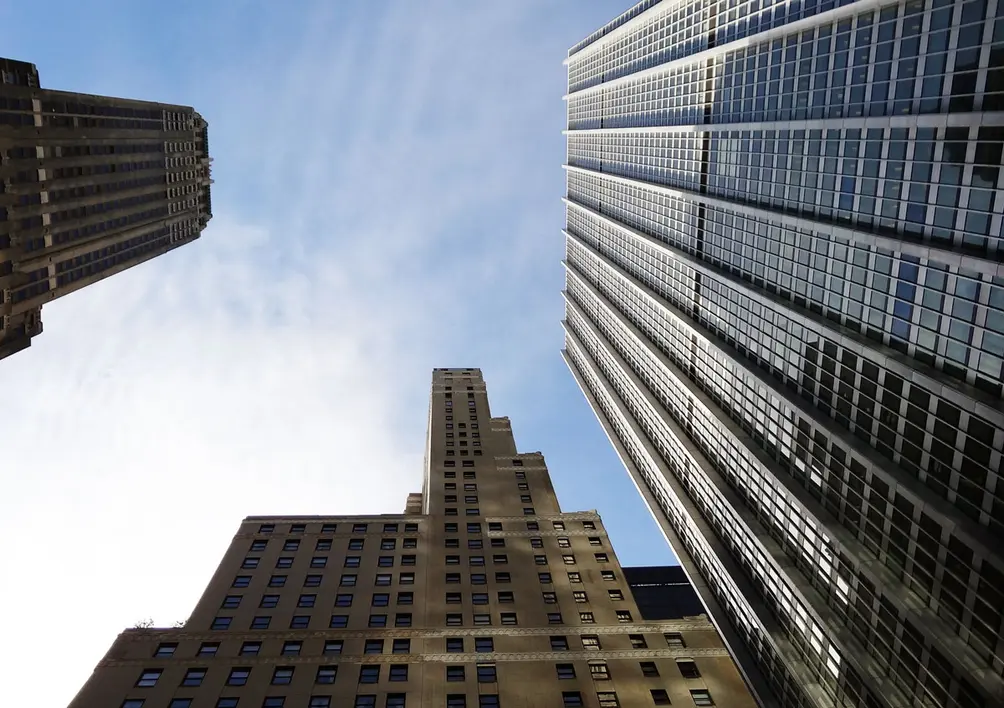
The designation report states that the plaza "originally constructed with white marble terrazzo paving and enclosed by a solid parapet of white travertine that was personally selected by Bunshaft in Tivoli, Italy. The L-shaped plaza levels the sloping site and conceals six floors of operations that would have been difficult to fit into a single floor of the tower, including an auditorium seating 800, the world's largest bank vault, and a staff cafeteria with the capacity to serve an estimated 10,000 meals a day.”
"Bunshaft and Noguchi," the report continued, "were frequent collaborators and became close friends. Their earliest project was an unexecuted raised garden for Lever House, followed by a group of square courtyards at the Connecticut General Life Insurance Company Headquarters (1957) near Hartford. Work on the 'Sunken Garden' began in 1961, during the period when Noguchi was planning a courtyard and sculptures for the Beinecke Library at Yale University. These commission share many characteristics: neither can be entered and, like the Zen Gardens he and Bunshaft visited during a trip to Kyoto a year earlier, were conceived for contemplation. Enclosed by large glass windows, both can be viewed from above or in the round. While both incorporate patterned paving, they differ in shape, form, and materials. The Beinecke courtyard features a level rectangular base, but the garden at Chase was, according to the artist: 'sculpturally treated - like the wild and surging shell of the sea and rising out or floating on it would be elemental rocks.' Noguchi selected seven black basalt rocks of various sizes taken from the bed for the Uji River near Kyoto, Japan....he told the Herald Tribune in 1963: ...the rocks I found in Japan for this garden contain a levitating as well as a gravitating quality. Some of them will seem to soar, others, remain close to earth.'"
Jean Dubuffet's sculpture was installed in the plaza in 1971 and not long afterwards the terrazzo in the plaza was replaced with granite pavers and the solid marble perimeter wall replaced with a glass wall.
Circular areas in the sunken garden were designed to hold seasonal displays of various flowers and plants and shortly after completion some passerby added some goldfish but the fish soon died "apparently victims of the brass piping and copper found in the numerous pennies pitched into the pool."
"Bunshaft and Noguchi," the report continued, "were frequent collaborators and became close friends. Their earliest project was an unexecuted raised garden for Lever House, followed by a group of square courtyards at the Connecticut General Life Insurance Company Headquarters (1957) near Hartford. Work on the 'Sunken Garden' began in 1961, during the period when Noguchi was planning a courtyard and sculptures for the Beinecke Library at Yale University. These commission share many characteristics: neither can be entered and, like the Zen Gardens he and Bunshaft visited during a trip to Kyoto a year earlier, were conceived for contemplation. Enclosed by large glass windows, both can be viewed from above or in the round. While both incorporate patterned paving, they differ in shape, form, and materials. The Beinecke courtyard features a level rectangular base, but the garden at Chase was, according to the artist: 'sculpturally treated - like the wild and surging shell of the sea and rising out or floating on it would be elemental rocks.' Noguchi selected seven black basalt rocks of various sizes taken from the bed for the Uji River near Kyoto, Japan....he told the Herald Tribune in 1963: ...the rocks I found in Japan for this garden contain a levitating as well as a gravitating quality. Some of them will seem to soar, others, remain close to earth.'"
Jean Dubuffet's sculpture was installed in the plaza in 1971 and not long afterwards the terrazzo in the plaza was replaced with granite pavers and the solid marble perimeter wall replaced with a glass wall.
Circular areas in the sunken garden were designed to hold seasonal displays of various flowers and plants and shortly after completion some passerby added some goldfish but the fish soon died "apparently victims of the brass piping and copper found in the numerous pennies pitched into the pool."
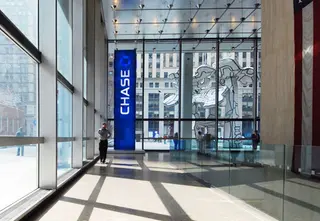
The building's large piers had been used recently at the Time-Life Building in midtown that had been designed by Harrison & Abramowitz & Harris and completed in 1960 and a much narrower variation was employed at SOM's Union Carbide Building on Park Avenue that was also completed in 1960.
There was a fire in the building's sub-basement in 1962, some windows popped in 1964 and a bomb went off in the bank's international department on the 16th floor in 1969 to protest the Vietnam War.
The bank moved its headquarters to midtown on 1996 and would later became known as J. P. Morgan Chase & Co. In 2008, the plaza was named to honor David Rockefeller who both worked at Chase for most of his career and supervised the planning and construction of the building.
In his 1979 book, “The City Observed, New York, A Guide to the Architecture of Manhattan,” Paul Goldberger wrote that “Chase’s boxy form dealt the first blow to the financial district’s classic skyline profile, a romantically jagged edge now turned into utter banality by all of this building’s progeny,” adding that the building also “initiated the pretentious and confusing custom, now imitated all over the nation, of calling office towers One This-or-That Plaza.”
There was a fire in the building's sub-basement in 1962, some windows popped in 1964 and a bomb went off in the bank's international department on the 16th floor in 1969 to protest the Vietnam War.
The bank moved its headquarters to midtown on 1996 and would later became known as J. P. Morgan Chase & Co. In 2008, the plaza was named to honor David Rockefeller who both worked at Chase for most of his career and supervised the planning and construction of the building.
In his 1979 book, “The City Observed, New York, A Guide to the Architecture of Manhattan,” Paul Goldberger wrote that “Chase’s boxy form dealt the first blow to the financial district’s classic skyline profile, a romantically jagged edge now turned into utter banality by all of this building’s progeny,” adding that the building also “initiated the pretentious and confusing custom, now imitated all over the nation, of calling office towers One This-or-That Plaza.”

Architecture Critic
Carter Horsley
Since 1997, Carter B. Horsley has been the editorial director of CityRealty. He began his journalistic career at The New York Times in 1961 where he spent 26 years as a reporter specializing in real estate & architectural news. In 1987, he became the architecture critic and real estate editor of The New York Post.

 6sqft delivers the latest on real estate, architecture, and design, straight from New York City.
6sqft delivers the latest on real estate, architecture, and design, straight from New York City.
